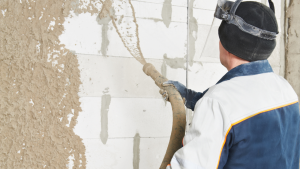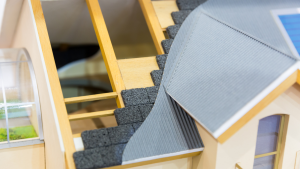Avoid having deteriorated stucco in your home, as it can lead to leakage, energy inefficiency, rain damage, and more. To address this problem, seek out reliable stucco contractors in East Brunswick to assist with repairs.
It’s essential to assess whether your stucco requires repair or remediation. Understanding the distinction between the two can guide you in determining the appropriate solution for your property—whether it’s stucco repair in East Brunswick or remediation.
If you need more clarification about the necessary steps for your situation, this article will guide you to help you make an informed decision. By making the right choice, you can select competent stucco contractors and obtain an accurate quote for the job.
What Exactly is Stucco Repair?
Stucco restoration involves a surface-level approach where a specialist repairs damaged stucco without addressing the underlying cause. The broken stucco is replaced with new material and given a smooth finish to match the original placement.
Contractors specializing in stucco in Middlesex County focus on repairing the damaged stucco without delving into the root cause. While considered a quick fix requiring minimal effort, contractors must proceed with caution to avoid damage to the house’s foundation, as improper methods can have adverse effects.
What Exactly is Stucco Remediation?
On the flip side, remediation is a more extended-term approach involving the identification and resolution of the underlying source of damage. While stucco repair in Burlington involves replacing old stucco with new material, remediation goes beyond, addressing the root cause and restoring the entire stucco system. The result is a defect-free surface that poses minimal risk to the building’s foundation.
Contrarily, stucco cleanup may incur a higher cost compared to repairs. Many homeowners opt for stucco contractor repairs because it provides a long-term, one-time solution. The principal benefit is its capacity to reinforce the stucco, reducing the likelihood of future maintenance.
Most Frequent Causes of Stucco Failure
Stucco is a durable, low-maintenance choice to enhance your home’s allure, curb appeal, and overall value. However, various environmental factors and craftsmanship-related issues may still lead to the eventual failure of your stucco.
Improper Installation of a Door or Window Sill
Inadequate installation of doors or windows can impede efficient water drainage from the property, potentially resulting in issues. Specifically concerning windows, improper placement by a stucco installer might lead to water being trapped if water-resistant paper is not correctly positioned behind the glass. This trapped moisture can foster mold growth and contribute to structural damage. Failure to adequately shield your stucco from humidity may lead to anticipated problems, including cracking and eventual disintegration.
Improper Installation of Flashing
The absence or improper fitting of kick-out flashing diverters, one-piece molded plastic or metal components designed to channel water flow effectively, may lead to the expected observation of cracks and deterioration in your stone and stucco work.
Difficulties with Material Transition
Failure to adequately seal joints between dissimilar materials for expansion and contraction can result in the initiation and exacerbation of cracking and water penetration. Transitions between stucco and other construction materials such as stone, concrete, siding, and brick may become problematic when proper sealing is neglected. Improper flashing of these seams, similar to issues observed with windows, doors, and chimneys, can cause significant damage to the stucco.
Tips for a Smart House Renovation
Nonetheless, specific issues such as cracks or faults can compromise the health of your home, necessitating renovation. Stucco is one of the finest materials for realizing your ideal home remodeling project. While home remodeling projects may seem daunting, you can turn your restoration aspirations into reality with the right tips and tactics. Before reaching out to stucco and stone professionals near me to enhance your property’s appearance, let’s discuss a few considerations before embarking on the home renovation journey.
Plan Your Budget
Every project requires a budget for successful completion. Striking a delicate balance between your home remodeling project and the budget you’ve allocated is crucial. It’s essential to accurately understand costs, encompassing materials, labor, and other vital elements. This precision will enable you to establish realistic expectations for the project.
Strategize the Build
Define the project’s scope precisely by outlining your essential needs and areas where you can compromise. Specify the necessary actions and their timelines to establish a clear objective for your endeavor. This thoughtful assessment will help prioritize tasks, determine the order in which they should be carried out, and identify any lessons that can be omitted.
Have Clear Goals
Before commencing the project, it is advisable to assemble all necessary materials, from tiles to appliances, that will be incorporated. Given that numerous decisions will arise during the renovation process, planning and organizing in advance is preferable to stay well-informed. Visiting showrooms, collecting samples, and exploring online home improvement resources like Pinterest can prove highly beneficial.
Monitor the Progress
The scope of your remodeling project largely hinges on the current condition of your home. If certain flaws are present, necessitating restoration of an entire area, such as experiencing a blown fuse when operating your hairdryer simultaneously, the condition may require a comprehensive overhaul of the whole house’s electrical system.
Hire the Best People
Having a team that aligns with your specific requirements is crucial, whether you’re searching for comprehensive construction firms or individual contractors to fulfill your home improvement needs. Instead of solely depending on word-of-mouth referrals, conducting a thorough background check on the contractors is advisable.
Verify Contractor’s License
Scrutinize their license, certification, employment history, and other credentials to ensure you are hiring the right individual for the job. It is equally important to find a team that comprehends your creative vision.
Sooner or later, you’ll survey your home and recognize its urgent need for a makeover. Whether you aim to enhance the current aesthetic or maintain it meticulously to boost its value, whatever the reason, “stucco” stands out as the ideal element that can turn your vision into reality.
Leverage What Stucco Can Do for You
Stucco is a versatile material suitable for various house designs and types and commonly found on many homes’ exteriors. Leveraging technology to renovate your home can be a creative and rewarding experience for you and the project team.
Stucco is offered in diverse colors, allowing you to achieve the precise look you desire for your home renovation project. For instance, opting for dark grey stucco can make your home stand out on the street, while a nectar stucco may impart a Tuscan character to your residence.
Utilizing stucco comes with the advantage of offering a variety of textures, allowing you to customize it to complement the style of your house.
As mentioned earlier, stucco is versatile, seamlessly complementing various materials. Pair white stucco with slate tiles, straight plank siding, and exposed concrete for a sleek appearance. Alternatively, a blend of gray textured stucco with cedar can create a striking contrast in your home.




